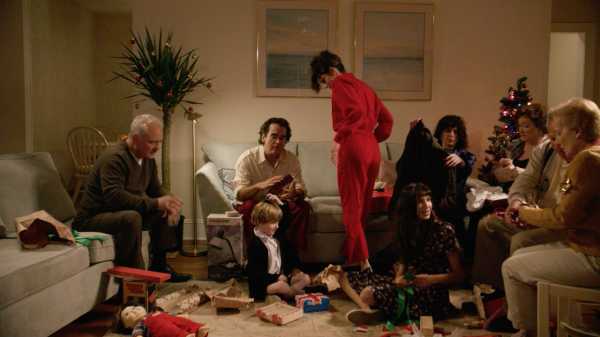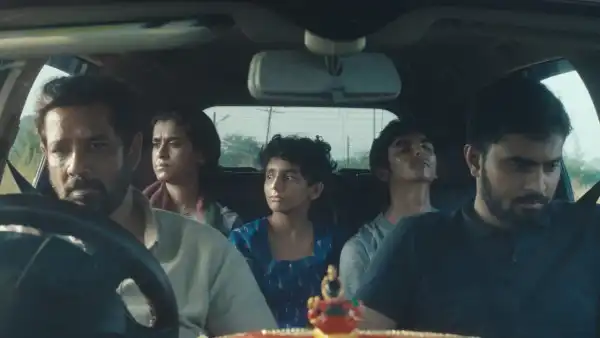
Low-budget filmmaking has never been a good financial proposition, but right now, caught between the pincers of streaming and the pandemic, it seems shakier than ever. It appears instructive that “The Cathedral,” the second feature by the New York-based filmmaker Ricky D’Ambrose, wasn’t funded by a production company but mainly by a grant from the Venice Biennale’s College Cinema program, which finances filmmakers’ first or second features with grants of a hundred and fifty thousand euros. Thanks to that micro-windfall, D’Ambrose was able to expand the scope, the span, the cast, and the material world of his new film far beyond anything that he’s hitherto done—which was already quite a lot. In the short films that he has made since 2015, and in his previous feature, “Notes on an Appearance” (2018), D’Ambrose has developed something more than a style—it’s a method that embodies an idea, one that’s joltingly original and instantly recognizable. (“The Cathedral,” which had its U.S. première at Sundance in January, is opening Friday in theatres and will be streaming on MUBI starting September 9th.)
D’Ambrose’s films are works of fiction that combine live-action drama and voice-over narration, accompanied by actual archival clips and faux documents (such as newspaper articles about his fictional characters). His idea is to inscribe his dramas in history—to unfold the connections between his characters and their times, to reveal the inseparability of private lives from public events, of personal concerns from political ones. In his earlier films, the presence of large historical events made for a striking, even disorienting, contrast with the spare fictional stagings that linked up with them. With the expanded scale of “The Cathedral,” D’Ambrose trades the disorientation for a greater sense of parallel—he integrates the private and public spheres. Moreover, the larger story that D’Ambrose tells is more or less his own: he amplifies his social vision to include the decades-long personal drama of a young person’s aesthetic education.
“The Cathedral” is a quasi-autobiographical, intellectual coming-of-age drama that tracks the young Jesse Damrosch from the year of his birth, 1987 (same as D’Ambrose’s), to the mid-aughts, through his childhood and adolescence on Long Island (where D’Ambrose grew up). The director’s alter ego develops an artistic sensibility—the very one that’s embodied in D’Ambrose’s films—and the emotional sensitivity to recognize the evasions and the lies, the hidden conflicts and the long-endured pain, that mark the lives of his parents and of his extended family circle. Jesse’s outer drama begins with his prehistory, which is dominated by several crises, starting with the death of his uncle in 1985. His uncle died of AIDS, though the family relentlessly denies it—a denial that broadens and deepens throughout Jesse’s life, and that also creates barriers and hazards that he and his family members are forced to negotiate. One of Jesse’s great-aunts is ostracized for reasons that remain obscure to him; the muffled dispute runs through his youth like an open wound.
Jesse is played, at different ages, by four different actors (Hudson McGuire, Henry Glendon Walter V, Robert Levey II, and William Bednar-Carter), and his presence, from early childhood to his first year of college, is an oddly contemplative one. He’s not seen spending much time on playdates, sports, or neighborhood rambles, but D’Ambrose never suggests that Jesse is isolated, friendless, or passive, either. There are big family events, such as vacations, a Christmas gathering, a funeral, Jesse’s third-birthday party, his confirmation, his high-school graduation, his parents’ divorce, and their remarriages—the ceremonies of private life, its points of contact with social institutions. These private landmarks echo public ones, which are marked in archival reports that Jesse sees or hears as breaking news: two wars in Iraq; two attacks on the World Trade Center; the crash of T.W.A. Flight 800, off the South Shore of Long Island; and the 2004 Presidential campaign. (One of D’Ambrose’s peripheral achievements is to remind viewers of the absurd calumnies levied against John Kerry in 2004, which foreshadowed today’s right-wing conspiracy follies.) All the while, Jesse’s strange and wondrous aesthetic is emerging, rooted in his fanatical visual acuity—his fine-grained fixation on such incidentals as the screaming red of a classroom fire bell, the visual rhythm of apple slices and a half-eaten sandwich on a plate, patterns of light and shadow on walls and ceilings and furniture, the beaming of sunlight through the foliage of trees.
With the help of blankly matter-of-fact yet omniscient voice-over narration (spoken by Madeleine James), D’Ambrose achieves the span and the depth of a cinematic bildungsroman in shards of experience and epigrammatic flickers. The principal experiences of Jesse’s upbringing are a nerve-racking combination of solicitude, tenderness, and love from his parents and his extended family and, at the same time, his mounting intuition—ultimately, his observation—of the appallingly aggressive, hostile, bitter, and cruel ways in which these nearest and dearest relatives treat one another, including during occasions and festivities that are meant to celebrate and delight him.
Much of the story has to do with money. There is the mystery of a loan that Jesse’s father, Richard (Brian d’Arcy James), gets from a friend (Steven Alonte) and its long reach through Jesse’s life. There is Richard’s resentment toward the wealth of Jesse’s maternal grandparents (Mark Zeisler and Geraldine Singer) as he struggles to sustain his printing business, which eventually goes bust. And there is Jesse’s growing awareness of the fundamental power of that wealth, even as a spark of violence. Other scenes involve family stories that Jesse hasn’t witnessed directly but that are nonetheless dramatized in grand and poignant detail—principally, the tale of the neglect and abuse that his great-grandmother (Candy Dato) endured at the hands of her son (Roy Abramsohn) and her daughter-in-law (Rosanne Rubino). These acts loom over the family’s life like a legend, with quasi-scriptural authority, and the actors’ concentrated fury and vulnerability lends D’Ambrose’s reserved manner a vital, sometimes terrifying dramatic intensity.
Jesse grows up amid a world of conflict, which fills his life with static even before he’s fully aware of its cause. The efforts to shield him from it, by way of evasion and deception, only intensify the sense that his surroundings are out of joint, that his intimate family sphere—far from a place where feelings can be freely shared, away from the judgmental eye of wider society—is a Kremlin-like web of undertones. As for the world at large, it’s no less complicated, and is a harrowing tangle of death and destruction. Nonetheless, Jesse’s keen visual perceptions and obsessions lead him to a fascination with photography, and to an early attempt at videography. If the movie has a skeleton key, it’s a sequence in which, as a high-school student, he explicates the patterns of light in a photograph of a pair of relatives, taken in 1989; the abstractions are inseparable from memories and personalities, the beauty inextricably bound with pain.
The only artistically and thematically comparable vision of a child’s sensibility and vulnerability developing together is in the British director Terence Davies’s films. In his second feature, “The Long Day Closes,” Davies’s young alter ego, amid pain at home and at school, experiences a soulful awakening through the community of group singalongs and the communion of movies. In “The Cathedral,” childhood is tragedy shrouded in mystery, and adulthood is tragedy tied to powers outside one’s control. But Jesse’s aesthetic, crystallizing amid private and public turmoil, is so abstract, lonely, and subjective that it offers no evident point of contact with those around him, except in his own mind—and, as it turns out, in D’Ambrose’s own cinema. “The Cathedral” itself asserts the principle and the power of its own rarefied aestheticism, namely, its ability to endow its family stories with the dignity and the complexity that they deserve. D’Ambrose portrays his loved ones not as isolated figures in a world of their own but as historical figures on the world stage—and he makes it clear that they bestowed upon him, in their own blundering but determined way, his own place on it, as actor and director, from the earliest age. ♦
Sourse: newyorker.com






